The 1996 BH Neumann Awardees were Peter O’Halloran, David Clark, Judith Downes, Josephine Edwards, Neville Grace, David Pederson, Robin Thornely and Giovanna Vardaro. The available citations follow.
![[Giovanna Vardaro]](https://web.archive.org/web/20180930115708im_/https://amt.edu.au/wp-content/uploads/bhnvardaro.jpg)
Peter Taylor, Executive Director of the Australian Mathematics Trust, Giovanna Vardaro and Professor Bernhard Neumann, after Giovanna was presented with her award by Professor Neumann in Adelaide, 23 February 1996.
Citation
Giovanna Vardaro is an outstanding example of a Bernhard Neumann Award recipient. For example, she
has been the State Director (for South Australia) of the Australian Mathematics Competition since 1985. This involves a lot of coordination work, dealing with problems within the state, checking the credentials of the leading scorers and liaison with the Australian Mathematical Olympiad Committee.
has, since its inception, been a member of the committee for the Mathematics Challenge for Young Australians, including its Enrichment Program. This committee is meeting here and involves a great degree of work constructing and refining problems outside of committee meetings and then through several weekend meetings each year.
has provided an outstanding inspiration and role-model as a teacher. This has been recognised elsewhere, e.g. the 1994 Satisfac Teacher Excellence Award as an outstanding teacher in South Australia.
has presented a number of papers at national and international conferences, both in Australia and overseas, on mathematical education.
as a member of the committee of MASA, has prepared student newsletters and organised maths activities such as the Jubilee 150 Maths Trail and Student Workshops.
I have a particular interest in this presentation. My grandmother was a student at Giovanna’s school when it was known as Methodist Ladies College. In 1904 she won the school prize for Maths (Algebra and Euclid) which I have here tonight. She also won other prizes, including German.
Peter Taylor
23 February 1996
![[Judith Downes]](https://web.archive.org/web/20180930115708im_/https://amt.edu.au/wp-content/uploads/bhndownes.jpg)
Judith Downes receives her BH Neumann Award from Professor Neumann at a function at the Riverwalk Hotel in Melbourne on 08 December 1996.
Tonight’s award, to Judith Downes, honours a very unique contribution to the advancement of mathematical enrichment in Australia.
This comes in two parts. First was a hands-on role in developing enrichment classes in Victoria. After having, as I am told, achieved one of the highest 1st Class Honours in Mathematics ever at Monash University she played a major part in developing enrichment classes for Victorian high school students (ie: students wishing to extend their mathematical knowledge).
She became associated with the Australian Mathematical Olympiad Committee, and while the record books show that she was not quite the first Victorian State Director, she took over in 1983 and really established the Victorian System as we know it, staying until 1988.
By this time she was changing career, to one of Accountancy. But she was not finished in her contribution. In 1991 she became treasurer of AMOC, playing a dominant role in establishing AMOC’s survival during later times when such funding ceased.
It was at this time that various forces suggested the value in merging AMOC with the AMF (which runs the AMC) to form the Australian Mathematics Trust.
The negotiations, as they always are in such mergers, were extremely difficult. Judith (with Prof Preston) was one of AMOC’s two negotiators and ensured that AMOC had equal status within the newly merged entity.
I might add that these negotiations led to a complicated structure, but the fact that there has been only one minor amendment to a complicated Trust Deed shows that the job was indeed well done.
Judith was able to stay on for a few more years to ensure that the Trust was on a strong footing.
Peter Taylor
08 December 1996
![[Neville bhn]](https://web.archive.org/web/20180930115708im_/https://amt.edu.au/wp-content/uploads/bhngrace1.jpg)
Neville Grace receiving his BH Neumann Award from Professor Neumann at a function at the Quay West Hotel, Brisbane, Wednesday 2 October 1996.
Neville with his family (Marie third from left) after the presentation.
Citation
Neville is well known within the Australian Mathematics Trust, having been State Director of the AMC for Queensland for about 11 years. But he also has a strong background in the teaching of mathematics on a state, national and more recently international basis.
He had an unusual beginning for a mathematician, having originally been self-employed in the Hotel business for over 10 years up to 1970. He then graduated with a B Ec at the University of Queensland, with a mathematics component and then a Dip Ed (Economics and mathematics at the same university.
From then Neville was a teacher at Richlands State High School and since 1980 he has been the Senior Education Officer (Maths) in the Queensland Department of Education. Since then he also completed a M Ed St at the University of Queensland, specialising in mathematical education.
He has written during that time teacher resource books covering the whole range of year levels through primary and secondary schools and was the Queensland project officer involved in the trial and provision of advice to writers of the national mathematics statement and profile for mathematics.
Neville was also joint author, with Kevin Olssen of Adelaide and others, of a support book “Using the National Mathematics Profile” for the Curriculum Corporation. He was also Project Officer responsible for the development and trial of Queensland “Student Performance Standards” (based on the national profile) and for a suite of projects to develop and produce a professional kit and variety of support materials for teachers across Years 4 to 8.
In professional societies, Neville has been most active. He was President for one term of QAMT, on its executive for ten years, Business Manager of “Australian Mathematics Teacher” and since 1988 member of the editorial panel for the QAMT journal “Teaching Mathematics”.
Recently, Neville was awarded the high honour of Life membership of QAMT to match his award from the Trust.
Most recently Neville has been an international consultant, with six visits to Tonga with the Australian Aid funded Tonga Education Project and he is about to start with the PROBE project in Manila.
To go with this we must point out that Neville has a great sense of humour and is most approachable and helpful when working with his colleagues.
This is an outstanding record of public service to mathematics education and our congratulations go to Neville for this appropriate recognition.
Peter Taylor
02 October 1996
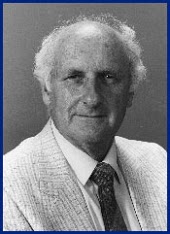
Peter Joseph O’Halloran (1931-1994)
The death occurred on 25 September 1994 of Peter O’Halloran, founder of the Australian Mathematics Competition and a range of national and international mathematics enrichment activities.
Peter was born in Sydney on 27 April, 1931, the youngest of a family of four boys and three girls. His father died when he was four years old, leaving the family in poor circumstances. His mother took in boarders to make ends meet and put several of the children through University.
Peter attended Marist Brothers School in Kogarah, Sydney, and it was there that he developed his life-long fascination with mathematics. He went on to the University of Sydney, on a government teaching scholarship, where he graduated with a Bachelor of Science and Diploma of Education.
Peter married Marjorie in 1955 and taught mathematics in several high schools in Sydney and the country regions. At Manly Boys High School, which had a noted discipline problem at the time, Peter also coached the Rugby Union and Rugby League teams, both with high degrees of success.
In 1965 Peter became head of mathematics at the Royal Australian Navy Academy at Jervis Bay. It was there that he completed a Master of Science, specialising in oceanography.
In 1970, now with four children, Peter and Marjorie moved to Canberra. Peter was one of the original appointments at the Canberra College of Advanced Education (later to become the University of Canberra) and taught in the first official semester of the CCAE. At the CCAE Peter developed other interests, including operations research and what was to become his main interest, discrete mathematics.
In 1972/3 he was the first CCAE academic to take study leave. Part of this was taken at the University of Waterloo, Canada, where he gained the idea of a broadly based mathematics competition for high school students. On his return he often enthused to his colleagues about the potential value of such a competition in Australia.
In 1976, while President of the Canberra Mathematical Association, he established a committee to run a mathematics competition in Canberra. This was so successful that the competition became national by 1978 as the Australian Mathematics Competition, sponsored by the Bank of New South Wales (now Westpac Banking Corporation). It is now well-known that this competition has grown to over 500,000 entries annually, and is probably the biggest mass-participation event in the country.
In 1979 he established the Australian Mathematical Olympiad Committee.The activities of this committee have grown to a complex web of competition and enrichment activities, at the highest level culminating each year in Australia’s participation in the International Mathematical Olympiad (IMO). Australia has participated internationally with distinction, for example this year being placed 12th out of 69 countries.
In 1983 Peter founded University of Canberra Mathematics Day, based on a similar event he had seen in America. This is now well-established and supports similar days in other parts of Australia. It has in turn become a model for other Mathematics Days throughout the world.
In 1984 Peter founded the World Federation of National Mathematics Competitions. For several years the main activity of the WFNMC was the production of a Journal, which acted as a vital line of communication for people trying to set up similar activities in other countries. In recent years its activities have expanded to include an international conference and a set of international awards (the Hilbert and Erdos Awards, to recognise mathematicians prominent in enriching mathematics education. Most recently, the WFNMC has become a Special Interest Group of the International Commission on Mathematical Instruction (ICMI).
One of the highlights of Peter’s career was hosting the 1988 IMO in Canberra, which attracted a record number of countries at the time and set new standards in many aspects of organisation.
In 1989 Peter established the Asia Pacific Mathematics Olympiad, providing a regional Olympiad for countries in the dynamic Pacific rim area.
In 1990 Peter completed the spectrum of competitions and enrichment activities in Australia, with the range of Challenge and Enrichment activities now organised by the Australian Mathematical Olympiad Committee.
Perhaps the most significant event in Peter’s career in the last two or three years was his role in the establishment of the Australian Mathematics Trust, which is an umbrella body administering all the activities with which he has been associated and which are referred to above.
Peter’s last main duty was to preside at the WFNMC conference in Bulgaria in July 1994. It was obvious to all who were there that Peter was ill. It was generally thought that he was experiencing another bout of pleuro-pneumonia, from which he had suffered in 1993. On his return home however further tests revealed that Peter’s condition was much more serious, and cancer was diagnosed. He spent most of his last month at home.
On 31 August he was presented with the David Hilbert Award, which he had declined to accept earlier in the year while still president of the WFNMC. A small party of 30 to 40 of Peter’s relatives and local colleagues were in attendance at his home. The David Hilbert Award is the highest international award of the WFNMC and in Peter’s case was awarded for “his significant contribution to the enrichment of mathematics learning at an international level”.
On 19 September he was awarded the World Cultural Council’s “Jose Vasconcelos” World Award for Education at a ceremony at Chambery, France. This award “is granted to a renowned educator, an authority in the field of teaching or to a legislator of education policies who has a significant influence on the advancement in the scope of culture for mankind”. The qualifying jury is formed by several members of the interdisciplinary Committee (of the World Cultural Council) and a group of distinguished educators.
Due to his illness Peter was unable to travel. Instead his eldest daughter Genevieve and son Anthony travelled to Chambery to receive the Award on his behalf. Fortunately Peter was still alive on 23 September on their return to Australia and was able to receive the award in person.
Peter was also recognised in many other ways throughout his career. In 1983 he was awarded the Medal of the Order of Australia (OAM), in 1991 he was awarded a Doctor of Science (honoris causa) from Deakin University and in 1994 he was promoted to Professor in his own University.
Many mathematicians have made significant individual contributions to the subject itself. Peter’s influence was much more direct, bringing mathematics to the world. With his driving energy and the institutions he created he has significantly increased people’s awareness of mathematics and what it can do, throughout the world.
One of Peter’s main concern in life was to assist the disadvantaged. He saw the AMC as being able to bring mathematics to children in remote places. In the earliest times of the AMC he travelled the Pacific and introduced the competition to a large number of island nations, such as Fiji, Tonga, Western Samoa, French Polynesia (for whom the paper was made available in French) and many smaller countries, some of which only had radio or occasional steamer contact with the outside world.
The Australian Government recognised these efforts and funded this project as one of the few cultural links between Australia and its Pacific neighbours.
Peter was proud of the fact that more than 50% of the AMC entrants were girls, but concerned that they did not get the same representation among the medals. He was also proud of the many letters he received from country schools, thankful for the opportunity to participate in the same event as their city cousins.
Peter saw the main advantage to be derived from the WFNMC was the help it could give to mathematics education in developing countries. I was seated next to him in a debate on the value of competitions at the 1992 International Conference on Mathematical Education in Quebec where he was paid the ultimate compliment to which he would have aspired. One delegate gave a well-planned attack on competitions, based on the usual lines, that competitions encouraged elitism, etc. In response, a delegate from the small African country of Malawi, unknown to Peter, responded with an emotional thank you to Peter and the people of the Australian Mathematics Competition for what they had made possible in her country. This was a most moving experience.
I made these observations to Peter’s eldest brother Ted after Peter’s funeral. Ted had become senior partner in one of Australia’s largest law firms before going into semi-retirement and was both a father-figure and inspiration to Peter. Ted reflected on these comments and noted the similarity between Peter and another brother Michael (now deceased). Michael had gone into the Marist order and had shown the same concerns for the disadvantaged. He had become responsible in the order for the distribution of international aid. It was probably no coincidence that Peter’s and Michael’s paths once crossed. Several years ago they found themselves together on the same remote Pacific island, each going about their own separate tasks.
Peter, of course will be irreplaceable. Fortunately, however, he had the foresight to establish institutions in such a way that they all have the resources, particularly human resources, to ensure that the good work will continue.
Peter is survived by his wife Marjorie, four children and six grandchildren.
Peter Taylor
Canberra
10 October 1994
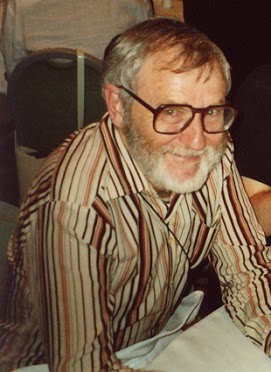
David Clark has done many things for the Trust since joining the AMF Committee in 1985 as a computer expert, writing system programs, etc. When informatics came along David joined that committee also and resigned from AMF in 2006 to focus on informatics. David was deputy leader of the Australian IOI team in 2001 to 2003, was Treasurer for a number of years and is the founding chairman of the Australian Informatics Competition Problems Committee.
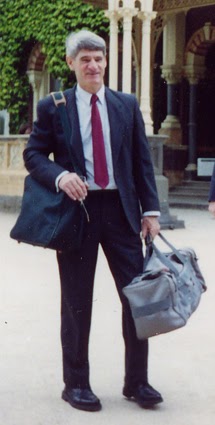
David Pederson, a Senior Lecturer in Statistics at the University of Canberra, joined the AMF Committee in 2005 after the death of Jo Edwards and for 20 years not only gave statistical advice but also edited the annual AMC solutions and statistics book.
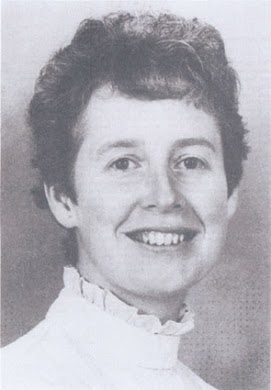
Josephine Dianne Edwards
Born Oxford 18 August 1942, died Canberra 25 May 1985
Josephine Dianne Edwards, Senior Lecturer in Mathematics at the Canberra College of Advanced Education, died in Canberra on 25 May after many months of illness.
Jo, as she was universally known, obtained a scholarship to read mathematics at Cambridge after attending the Ursuline School in Brentwood.
She came to Canberra in 1964 and taught mathematics for a number of years in ACT Secondary Schools, including Daramalan, Watson, Telopea Park and Canberra Grammar. In 1975 she was appointed to the mathematics staff of the Canberra College of Advanced Education.
Throughout her professional life she was a most dedicated, thoughtful and sensitive teacher of mathematics. She gave great energy and thought to her teaching preparation in order to make the most complicated concept in mathematics understandable by all of her students … as she had written on the board of her room at the CCAE – “Everything is simple once you know how”. Jo was an active member of the Canberra Mathematical Association for 18 years and has served at various times as its President (1983-4), Vice President (1984-5) and Secretary (1982-3).
While at the Canberra CAE, Jo was responsible for first year mathematics units, with up to 350 students, as well as establishing the mathematics laboratory. In recent years she was also responsible for designing a special unit for pre-service mathematics education of intending primary and early education teachers.
It was because of her concern for the encouragement of school students to achieve their full potential that she was one of the creators of the Australian Mathematics Competition. Here, she played a significant role.
She was the foundation chairman of the Organising Committee, a m ember of the AMC Board of Governors (1977-1985), and Editor of AMC Publications since 1979, including the annual Solutions and Statistics Booklet and the pamphlets Number Skills Can Open Many Doors and Maths is Solving Real Problems. She was also an Associate Editor of the USA publication College Mathematics Journal.
Her great strengths included her deep concern for the welfare of all her students as well as her extraordinary organisational ability, whether in helping her set up the AMC admiistration or in running the CCAE’s large first year mathematics units.
Using the vast AMC data file, Jo had undertaken research on students’ achievements in mathematics, particularly in boy/girl comparative levels of success. Her intention was to maintain the high standard of the AMC and to ensure that its contribution to Australian education continued to be both positive and effective.
She has had a number of articles on mathematical education published in various journals in Australia, Canada and France. At the time of her death, she was editor of the nearly completed, 200 page book to be titled The Best of the AMC.
Jo will be greatly missed, not only by her family, but by members of the mathematics teaching confraternity in Canberra, by staff and students at the Canberra CAE and in particular all those people throughout Australia who are involved with the AMC.
Peter J O’Halloran OAM
June 1985
The following obituary appeared in the Canberra Times on 29 May 1985.
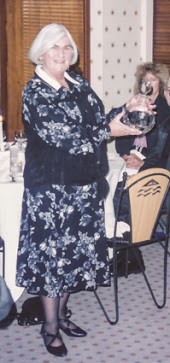
Robin Thornely retired as Deputy Principal of Canberra High School after a long and distinguished career in NSW and ACT government high schools. She was a member of the AMC Problems Committee for 15 years.

![[Neville bhn]](https://web.archive.org/web/20180930115708im_/https://amt.edu.au/wp-content/uploads/bhngrace3.jpg)